Van mijn collega kleipijpen-verzamelaar Freek Mayenburg kreeg ik een onbekende pijp met een voorstelling onder ogen met de mededeling: daar mag jij je op uitleven om de betekenis ervan te achterhalen.
Het is bekend van pijpenmakers uit de 19e eeuw dat zij pijpen maakten met voorstellingen over een spraakmakende of bijzondere gebeurtenis, om zo voor de kopers aantrekkelijke pijpen te kunnen maken, en zelf hun omzet te kunnen verhogen. Het is leuk door googlen en te speuren op internet om de betekenis van de voorstelling op de pijp te achterhalen.
BESCHRIJVING VAN DE PIJP
De pijp heeft een bolle ketel met een vooruitstekende hiel die het merk molen draagt. De steel loopt vanuit de ketel schuin omhoog, waarvan we niet weten of hij recht of gebogen was omdat hij ontbreekt, maar meest waarschijnlijk is gebogen.
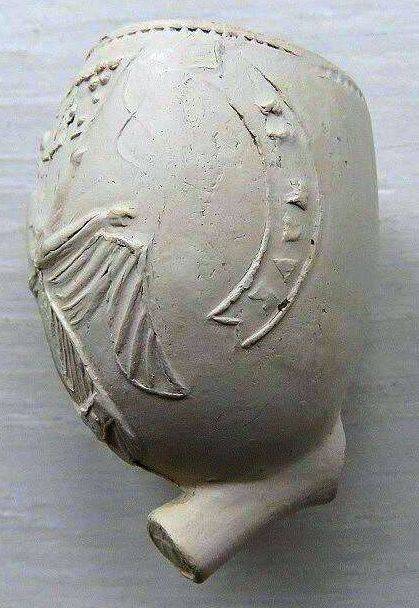

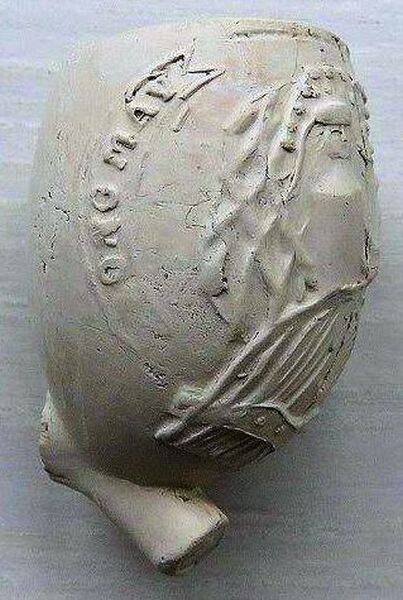
Op de achterzijde van de ketel staat een vrouw afgebeeld met een vlag. Daar omheen is een tekstlint te zien waarvan wel enkele letters herkenbaar zijn maar wat er echt staat is niet echt leesbaar. Het model van de pijp komt niet dikwijls voor maar komt overeen met een pijp die ik eerder heb beschreven in het artikeltje E PLURIBUS UNUM die zo rond 1890 is gemaakt, ook pijpjes met zo'n vooruitstekende hiel zijn bekend van Jan de Gidts met Koning Willem I en III die zo rond 1863 zijn te dateren. Dit pijpje stamt dus mogelijk ook uit die periode zo rond 1860 - 1865.
ZOEKEN OP INTERNET
Zoomen we in op de voorstelling dan zien we dat de vlag sterren bevat, met die informatie ben ik gaan googlen naar vrouw en vlag met sterren. Na lang speuren en zoeken op het internet kwam ik een afbeelding tegen die zonder twijfel dezelfde elementen in zich draagt als de voorstelling op de pijp.
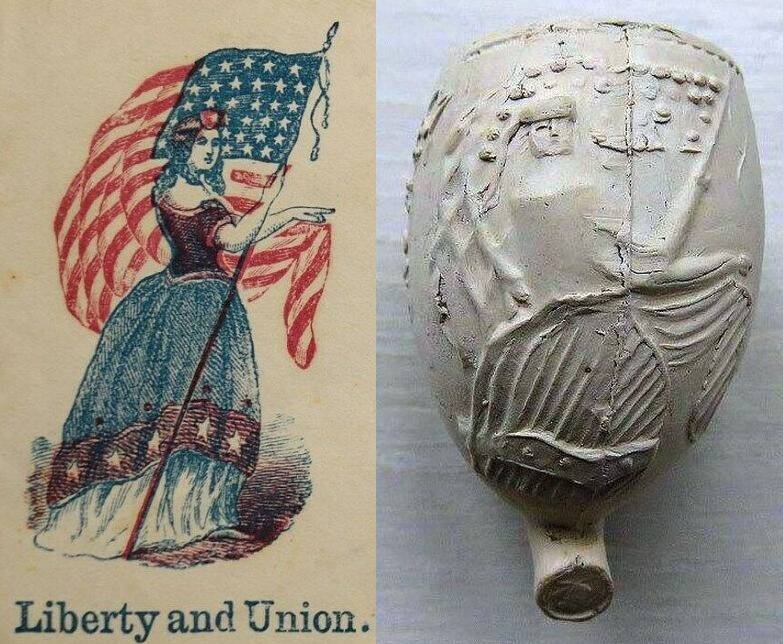
Het is een patriotische afbeelding uit Amerika in de tijd dat er een burgeroorlog heerste van 1861 tot 1865 tussen de Noordelijke staten (de Unie) en de Zuidelijke staten (de Confederatie). De afbeelding komt van een envelop die door patriotten uit de Noordelijke staten werden gebruikt. Afgebeeld staat Lady Liberty met vlag die naar de overwinning wijst met daaronder de tekst Liberty and Union "Vrijheid en Eenheid". Er waren in die periode heel veel varianten van deze voorstelling. De overeenkomsten tussen de afbeelding op deze envelop en pijp zijn duidelijk, we zien Lady Liberty met vlag, ze wijst met haar linkerhand terwijl ze ook nog een slip van de vlag vasthoudt naar de overwinning, ook zien we onder in haar rok een band met sterren. De tekst op de pijp was op een paar letters na slecht te lezen, maar met de informatie tot nu toe over deze pijp heb ik mij er nog eens over gebogen. Heb de tekst horizontaal geplaatst en van beide ketelhelften naast elkaar geplaatst, toen kon ik vaag het woord WAVE lezen als laatste woord op de linkerhelft van de pijp. Dit bracht mij op het goede spoor want dat woord had ik ook gelezen op de litho uit 1860 die onderin het artikel wordt getoond. Onder de litho staan een aantal zinnen uit het "The Star-Spangled Banner" het Amerikaanse volkslied. En de eerste zin onder de afbeelding komt overeen met de tekst op de pijp. Long may it wave "Moge het lang wapperen".
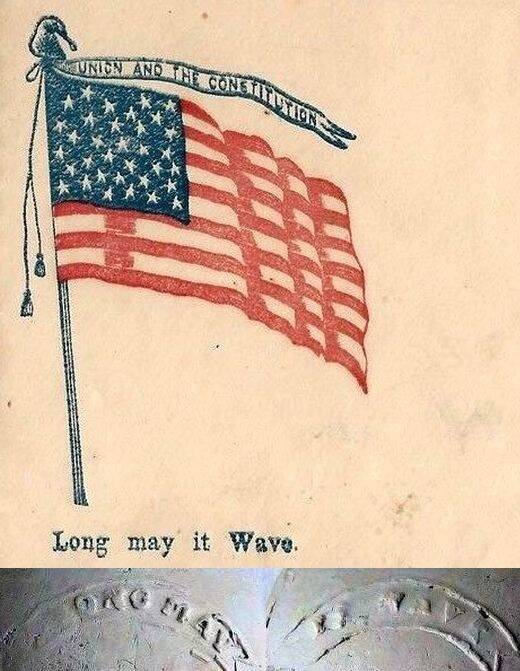
Verder op internet gezocht, en yes BINGO, net als Lady Liberty met de tekst "Liberty and Union" werd door de patriotten het motto "Long may it wave" gebruikt vergezeld van de Amerikaanse vlag op envelopen waar ze hun brieven in verstuurden. We zien dat de vlag 34 sterren draagt. De 34e ster werd toegekend aan Kansas in 1861, dat was hetzelfde jaar waarin de 13 Zuidelijke staten zich afscheidden, waarna de Amerikaanse burgeroorlog ontstond.
DE GRAVURE
Kleipijpen worden gemaakt door een rol klei tussen twee metalen mallen, veelal van messing, te persen. In de mal werden door een zilver of goudsmit in spiegelbeeld een afbeelding en/of tekst gegraveerd zodat als de pijp uit de mal kwam de voorstelling mooi zichtbaar en leesbaar was. De messing mallen hadden wel het nadeel dat ze snel sleten en dat ze na veelvuldig gebruik opgehaald moesten worden om de voorstelling weer duidelijk te krijgen. Op de afbeelding hieronder zien we een ijzeren pijpenmal met dotter.
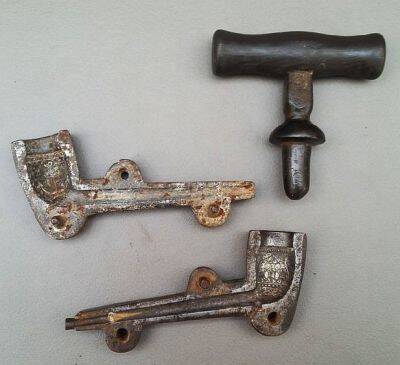
De gravure op de pijp hier beschreven is, als we deze vergelijken met wat we kennen van pijpen uit de 18e en 19e eeuw, geen hoogstandje. Lady Liberty wordt zeer houterig weergegeven en het is in zijn geheel gezien een zeer grove voorstelling. De hiel draagt het merk Molen wat ons brengt, gezien de tijd waarin de voorstelling actueel was, bij de pijpenmaker Frans Simon Sparnaaij een Goudse pijpenmaker die werkzaam was van 1839 tot 1880.
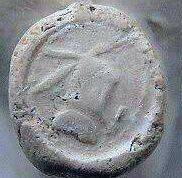
De pijpen uit het assortiment van Frans Simon Sparnaaij die versierd waren zijn qua gravure geen hoogstandjes maar wel van een betere kwaliteit dan de pijp hier beschreven. Het zou kunnen dat de mal is gegraveerd door een leerling en toch is gebakken bij de pijpenmaker Frans Simon Sparnaaij om het resultaat te zien. In de zestien jaar dat ik pijpen verzamel heb ik deze pijp nog niet eerder gezien, ook in de boeken en in andermans verzamelingen en op internet heb ik deze pijp niet terug kunnen vinden. Zou kunnen dat hij dus nooit is uitgebracht wat ik mij voor kan stellen gezien de slechte kwaliteit van de voorstelling, maar het blijft een zeer interessante pijp.
BRON AFBEELDING LIBERTY AND UNION OP DE ENVELOP
Zoals de voorstelling op de pijp afgekeken is van de afbeelding op de envelop (LIBERTY and UNION) zo is de afbeelding op de envelop mogelijk afgekeken van een litho van Currier & Ives uit ± 1860, met dat verschil dat hier de band met sterren op de rok ontbreekt. The Star-Spangled Banner (de met sterren bezaaide banier) is het Amerikaanse volkslied en verwijst naar de vlag van de Verenigde Staten. De tekst van het Amerikaanse volkslied is geschreven door Francis Scott Key in 1814, een 35 jarige advocaat en dichter. Het was een populair deuntje in de 19e eeuw wat vooral tijdens vieringen van Independence Day "Onafhankelijkheidsdag" op 4 juli werd gezongen. Pas later op 3 maart 1931 wordt het officieel het volkslied van de Verenigde Staten. Op de litho zien we Lady Liberty gekroond met een Amerikaans wapen, de Amerikaanse vlag, en zij wijst naar de overwinning, die plaats vond in 1814: de verdediging van het Fort McHenry door de Amerikaanse troepen tijdens de Britse aanval op 13 september. De litho verwijst dus naar een gebeurtenis in de Amerikaanse geschiedenis die eerder plaatsvond.
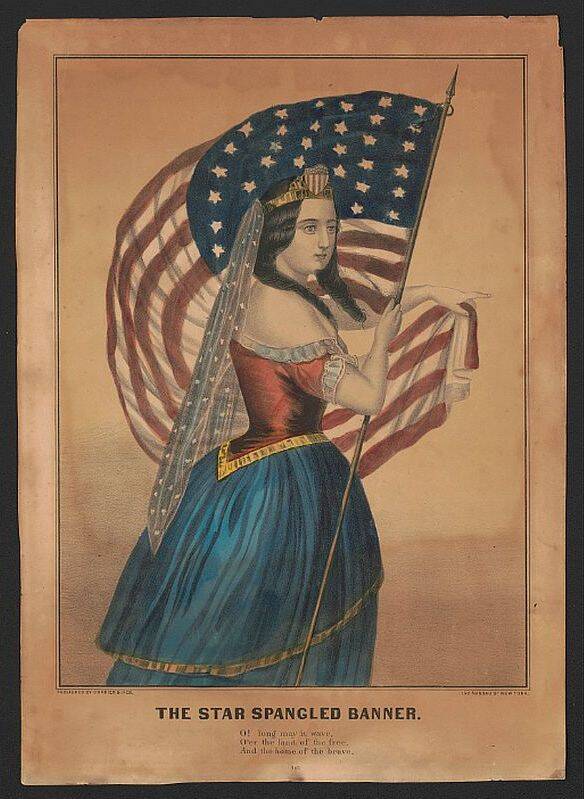
De tekst onder de voorstelling luidt: O! long may it wave, O'er the land of the free en And the home of the brave. De drie laatste zinnen uit het tweede couplet van het Amerikaanse volkslied.
Hoe de voorstelling of envelop in Nederland terecht is gekomen is niet bekend, maar mogelijk heeft iemand een brief ontvangen uit Amerika met deze patriotische voorstelling. Het is ook niet ondenkbeeldig, want er waren voor de burgeroorlog daar uitbrak veel Nederlanders geëmigreerd door de slechte economische omstandigheden in ons land. Die brief zal maanden onderweg geweest zijn want in die tijd was er nog geen luchtpost en zal hij per boot hier terecht zijn gekomen. Of het in Nederland echt een actuele gebeurtenis was weet ik niet, men zal er wel van geweten hebben, maar er was in die tijd dat die burgeroorlog plaatsvond 1861 - 1865 geen televisie of radio waardoor het meer een ver van je bed show zal zijn geweest. Zou ook kunnen zijn dat de pijp is gemaakt voor export want de patriotische voorstelling en Engelse tekst "Long may it wave" zal de pijprokers in de Noordelijke staten van Amerika meer aangesproken hebben dan de Nederlandse pijproker, en dat zou ook de reden kunnen zijn dat de pijp in Nederland vrij onbekend is en niet veel gevonden is

From my fellow clay pipe collector, Freek Mayenburg, I received an unknown pipe with a depiction on it, along with the remark: “this one is for you to figure out the meaning of.”
It is known from 19th-century pipe makers that they produced pipes with depictions of remarkable or noteworthy events, in order to make their pipes more appealing to buyers and thus increase their sales. It is enjoyable to google and search online to uncover the meaning behind the scene on the pipe.
DESCRIPTION OF THE PIPE
The pipe has a rounded bowl with a protruding heel that bears the mill mark. The stem rises diagonally upward from the bowl, though we do not know whether it was straight or curved since it is missing — but most likely it was curved.
On the back of the bowl, a woman is depicted holding a flag. Around her is a ribbon of text, of which a few letters are recognizable, but the full inscription is not really legible. The model of the pipe is not very common, but it corresponds to a pipe I previously described in the article E PLURIBUS UNUM, made around 1890. Pipes with such a protruding heel are also known from Jan de Gidts, featuring King William I and III, which can be dated to around 1863. This pipe may therefore also originate from that same period, around 1860–1865.
SEARCHING ON THE INTERNET
When zooming in on the depiction, we can see that the flag contains stars. With that information, I started googling “woman and flag with stars.” After much searching and browsing online, I came across an image that undoubtedly carries the same elements as the depiction on the pipe.
It is a patriotic image from America, dating to the time of the Civil War (1861–1865) between the Northern states (the Union) and the Southern states (the Confederacy). The image comes from an envelope that was used by patriots from the Northern states. Depicted is Lady Liberty with a flag, pointing toward victory, with the words Liberty and Union below: “Freedom and Unity.” During that period, there were many variations of this depiction.
The similarities between the image on this envelope and the pipe are clear: we see Lady Liberty with a flag, pointing with her left hand toward victory while also holding a slip of the flag, and at the bottom of her dress we see a band decorated with stars. The text on the pipe was, apart from a few letters, very hard to read, but with the information gathered so far about this pipe, I revisited it. I placed the text horizontally and aligned both halves of the bowl side by side, and then I could vaguely make out the word WAVE as the last word on the left half of the pipe.
This put me on the right track, because I had also seen that word on the lithograph from 1860 shown at the bottom of the article. Below the lithograph are several lines from The Star-Spangled Banner, the American national anthem. And the very first line under the image corresponds with the text on the pipe: “Long may it wave.”
I continued searching on the internet, and yes — BINGO! Just like Lady Liberty with the text “Liberty and Union”, the motto “Long may it wave” was also used by the patriots, accompanied by the American flag on the envelopes in which they sent their letters. We can see that the flag carries 34 stars. The 34th star was added for Kansas in 1861, which was the same year the 13 Southern states seceded, leading to the outbreak of the American Civil War.
THE ENGRAVING
Clay pipes are made by pressing a roll of clay between two metal molds, most often brass. In the mold, a silversmith or goldsmith would engrave an image and/or text in mirror image, so that when the pipe came out of the mold, the design was clearly visible and legible. Brass molds did have the disadvantage of wearing out quickly, and after frequent use they had to be re-engraved to make the depiction sharp again.
In the image below we see an iron pipe mold with a dotter. The engraving on the pipe described here is, when compared with what we know from pipes of the 18th and 19th centuries, not of high quality. Lady Liberty is rendered in a very stiff manner, and overall the design is quite crude. The heel bears the mill mark, which brings us — considering the time when the image was topical — to the pipe maker Frans Simon Sparnaaij, a Gouda pipe maker active from 1839 to 1880.
The decorated pipes from the range of Frans Simon Sparnaaij are not masterpieces in terms of engraving, but they are of better quality than the pipe described here. It is possible that the mold was engraved by an apprentice and nevertheless fired by the pipe maker Frans Simon Sparnaaij in order to see the result. In the sixteen years that I have been collecting pipes, I have never come across this one before. I have also not found it in books, in other people’s collections, or on the internet. It may therefore be the case that it was never released — which I can imagine, given the poor quality of the depiction — but it remains a very interesting pipe.
SOURCE IMAGE “LIBERTY AND UNION” ON THE ENVELOPE
Just as the design on the pipe was copied from the image on the envelope (LIBERTY and UNION), the image on the envelope itself may have been copied from a lithograph by Currier & Ives dating from around 1860, with the difference that in the lithograph the band of stars on the skirt is missing. The Star-Spangled Banner is the national anthem of the United States and refers to the American flag. The text of the anthem was written in 1814 by Francis Scott Key, a 35-year-old lawyer and poet. It was a popular tune in the 19th century, especially sung during Independence Day celebrations on July 4. It was only later, on March 3, 1931, that it officially became the national anthem of the United States.
In the lithograph, we see Lady Liberty crowned with an American emblem, holding the American flag, and pointing toward victory — the victory that took place in 1814: the defense of Fort McHenry by American troops during the British attack on September 13. The lithograph therefore refers to an event in American history that took place earlier.
The text beneath the depiction reads: “O! long may it wave, O’er the land of the free / And the home of the brave.” These are the last three lines of the second verse of the American national anthem.
How the image, or the envelope, found its way to the Netherlands is not known, but it is possible that someone received a letter from America bearing this patriotic illustration. That is not unthinkable, as many Dutch people emigrated before the outbreak of the Civil War due to the poor economic conditions in our country. Such a letter would have taken months to arrive, since there was no airmail at the time, and it must have come by ship.
Whether this was truly seen as a topical event in the Netherlands is uncertain. People would have been aware of it, but during the Civil War years (1861–1865) there was no television or radio, so it would have felt more like a distant event. It is also possible that the pipe was made for export, since the patriotic imagery and the English motto “Long may it wave” would have appealed far more to pipe smokers in the Northern states of America than to Dutch smokers. That could also explain why the pipe is relatively unknown in the Netherlands and rarely found.
Met dank aan Freek Mayenburg
1a. FM
1b. Gouda Koningshof
2a. Izabé met een bolle ketel
2b. Lady Liberty met de Amerikaanse vlag terwijl ze naar de overwinning wijst.
2b. Tekstlinten: LONG MAY / IT WAVE
2c. -/-
2d. Molen
2e. Ongeglaasd
2f. Gebotterd
2g. Radering bij de ketelrand
2h. -
3a. -
3b. -
3c. -
4. 1860 - 1865
5. Gouda
6. Frans Simon Sparnaaij
7. -